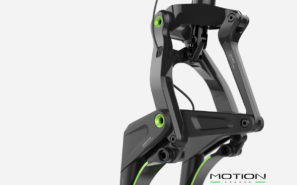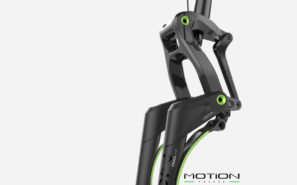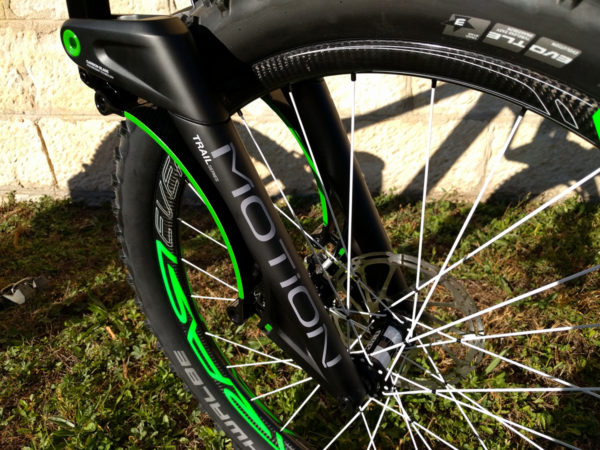There’s a new suspension fork on the horizon, and it looks like it will check off a number of boxes. Like all the boxes. If the new Motion fork from Motion France delivers on all of their claims, it will be a one size fits almost all fork with adjustable travel, no brake dive, and limited maintenance. On paper, the Motion fork seems like it could be a truly groundbreaking design, but there is one catch…
One of the biggest benefits claimed by Motion France is the fact that their fork design eliminates diving of the fork under braking. Theoretically, that should leave more suspension travel available to absorb impacts even under braking which is highlighted in one of their videos. Whereas typical suspension forks try to manage brake dive through adjustable low speed compression, the linkage design of the Motion fork seems to accomplish this without damping.

That’s not to say there isn’t any damping though – unlike other carbon leaf spring forks the Motion has a hydraulic cartridge hidden in the steerer which seems to just affect rebound and lock out. Utilizing an adjustment wheel on top of the stem, users can choose between 10 levels of rebound damping and also lock out the fork with the push of a button. The lockout is also adjustable with an allen wrench.
Also adjustable is nearly everything else on the fork – wheel size, axle size, and carbon springs for different rider weight and suspension travel. We’ve reached out for clarification, but the press materials sent our way it seems that there is one main chassis that is then incredibly adaptable. There are three different chassis – one for 26″ wheels, one for 27.5″ and 26+, and one for 27+, 29″, and 29+. Then there’s the axle system which accepts 15×100, 15×110, or even 20×110. Just about the only thing that this fork won’t accept is a straight 1 1/8″ steerer due to the damping cartridge inside.
Users can also swap out the carbon springs which can change the fork for different rider weights or for different travels. Depending on the wheel size, travel is adjustable through an incredible 100-170mm range. Supposedly, this can all be done without tools and should be pretty quick. As for the suspension itself, the carbon springs are only utilized in traction (pulling) rather than compression which Motion France says provides better small bump compliance and a progressive suspension rate. Carbon blades are chosen by rider weight, with spring width varying by 4mm from 20-40mm total widths. Sag is another thing that can be adjusted via individual wheel adjusters on the bottom of each fork leg. Even with everything going on, the fork has a claimed weight of 1850g, though it will only accept 180-200mm rotors.
Motion France claims that their use of bushings instead of bearings at the pivots that are secured without bolts ensures a maintenance free construction. That same claim covers the sealed hydraulic cartridge for rebound. It seems crazy that they’re willing to state that a suspension fork will need zero maintenance, but if the pivots are pressed together without bolts and the cartridge is sealed, maybe there’s no maintenance that could actually be done. Given the lifetime warranty on the chassis and blades (5 year on the hydraulic cartridge), it seems they’re willing to back it up.
You have to admit, at this point the fork is sounding pretty good. The catch? Well, you can’t expect something that could be this ground breaking to come cheap, right? Available for preorder through Kickstarter, the fork starts out at the Extra Early Bird price of €1,250 (about $1400). That is half the price of the expected retail. Yes, the retail price is projected somewhere north of $2,700 (€2500). However, Motion France has been working on the Motion fork for a few years now, with some big partners in France including Michelin, Rotor, and more. We’re assuming that if the Kickstarter is successful, and the fork works as advertised, we’ll see more affordable versions down the pipe. But for now, the Kickstarter is looking pretty appealing…
https://www.kickstarter.com/projects/929331044/motion-france-dynamic-anti-dive-mtb-fork








